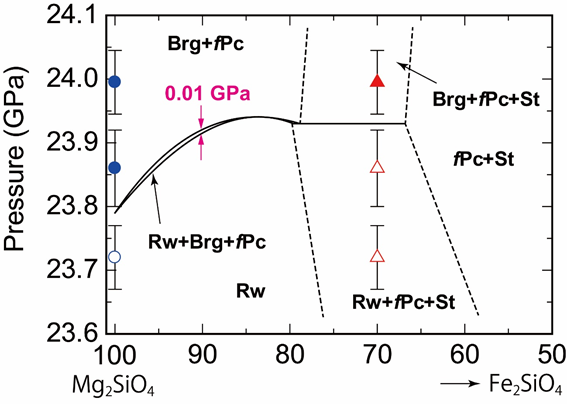
Novel experiments at BGI explain the sharpness of the 660 km discontinuity
T. Ishii, R. Huang, R. Myhill, H. Fei, I. Koemets, Z. Liu, F. Maeda, L. Yuan, L. Wang, D. Druzhbin, T. Yamamoto, S. Bhat, R. Farla, T. Kawazoe, N. Tsujino, E. Kulik, Y. Higo, Y. Tange, T. Katsura
Sharp 660-km discontinuity controlled by extremely narrow binary post-spinel transition
Nature Geoscience, https://doi.org/10.1038/s41561-019-0452-1
The Earth’s mantle shows an abrupt increase of seismic velocities at a depth of 660 km, referred to as the 660-km discontinuity. Mineral physics data suggest that ringwoodite decomposes to bridgmanite plus ferropericlase around a pressure corresponding to the depth of 660 km. It has therefore been considered that the 660-km discontinuity is caused by this “post-spinel transition”.
One of the prominent features of the 660-km discontinuity is that it occurs over an interval of less than 2 km, corresponding to 0.1 GPa variation in pressure. This extreme sharpness could not be duplicated by any laboratory experiment. One reason is that the pressure resolution in previous studies was limited to 0.2~0.5 GPa. Another reason may be that during previous experiments, sample pressures dropped more than 2 GPa even at constant temperature and press load. We developed high-precision pressure measurements with an accuracy of 0.05 GPa by in situ X-ray diffraction, and attempted to keep sample pressures constant by finely controlling press load. By combining such state-of-the-art high-pressure experiments with thermochemical calculation, we were able to demonstrate that the pressure interval of the post-spinel transition is only 0.01 GPa, corresponding to a thickness of the discontinuity of 250 m.
These results are more than sufficient to explain the sharpness of the discontinuity, and provide new support for whole mantle convection in a chemically homogeneous pyrolitic mantle. The present work also proposes a new method to detect flow between the upper and lower mantle based on discontinuity sharpness, because the interval should increase by a rapid flow across the 660-km discontinuity.

Phase relations in the system Mg2SiO4-Fe2SiO4 at a temperature of 1700 K.
Brg: bridgmanite, fPc: ferropericlase, Rw: ringwoodite, St: stishovite. At mantle composition, the width of the Rw + Brg + fPc loop is only 0.01 GPa in pressure, corresponding to 250 m in depth. This width becomes even smaller for a mantle temperature of 2000 K. The horizontal axis is the fraction of Mg2SiO4 component.
Tel: +49-(0) 921 55 3700 / 3766, Fax: +49-(0) 921 55 3769, E-mail: bayerisches.geoinstitut(at)uni-bayreuth.de